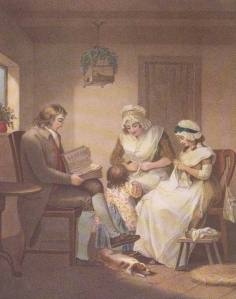 In December 1859, Florence Nightingale wrote this letter of recommendation to Parthenope Verney:
In December 1859, Florence Nightingale wrote this letter of recommendation to Parthenope Verney:
My dear [Parthenope Verney]
It occurred to me after writing yesterday if you are going to set up a needlewoman under the housekeeper, Mary Jenkins, Bathwoman, Dr. W. Johnson’s, Great Malvern, has a niece, living at Oxford, a first-rate needlewoman, eldest girl of a very large family, who wants or wanted a place. If she is at all like my good old friend, her aunt, she would be a very valuable servant. Perhaps her needlework would be almost too good for your place. I believe she is a qualified “young lady’s maid,” though when I heard of her, she had never been “out,” i.e., in service. Perhaps she has a place. I think it answers very well in a large house to have as much as possible done at home, as little as possible “put out.”
This domestic job as needlewoman – mending, embroidering, making clothes – sounds benign compared to the custom of the Regency and Victorian eras to overwork seamstresses. While plying the needle was a common domestic activity (Jane Austen was known to possess a particular talent in this direction), working class seamstresses were appallingly overworked and underpaid, especially during the heyday of the Industrial Revolution. Many women toiled for long hours in poor lighting conditions, with some going blind from their employment. An apprentice seamstress in a milliner’s shop worked under slightly better conditions, but during the Season when demand for new and fashionable dresses was high, these women would also be pressed to work into the wee hours of the night to complete an order.
The above illustration of Jane Austen sewing comes from Jane Austen: Her Homes and Her Friends by Constance Hill. In Chapter XX, Constance makes the following observation about Jane Austen’s skill as a needlewoman:
Her needlework was exquisite. We have seen a muslin scarf embroidered by her in satin-stitch, and have held in our hands a tiny housewife of fairy-like proportions, which Jane worked at the age of sixteen as a gift for a friend. It consists of a narrow strip of flowered silk, embroidered at the back, which measures four inches by one and a quarter, and is furnished with minikin needles and fine thread. At one end there is a tiny pocket, containing a slip of paper upon which are some verses in diminutive handwriting with the date “Jany. 1792.” The little housewife, when rolled up, is tied with narrow ribbon. “Having been never used and carefully preserved, it is as fresh and bright as when it was first made.
For more on this topic, click on my other post The Life of a Seamstress.
Read Full Post »

 The abstract of
The abstract of 
 When I saw Princess Charlotte’s bellflower court dress (1814-16) at the Museum of London I remember being transfixed and standing in front of the glass case for a half hour. I could not get over the exquisite details and embroidery of this gossamer thin gown, and wondered at the hours it took to create it, the number of seamstresses that must have toiled over it, and its cost. It was so beautiful that I mistook it for a wedding dress. The train, which showed slight damage where some of the embroidered bells were missing, is similar to the one on Princess Charlotte’s
When I saw Princess Charlotte’s bellflower court dress (1814-16) at the Museum of London I remember being transfixed and standing in front of the glass case for a half hour. I could not get over the exquisite details and embroidery of this gossamer thin gown, and wondered at the hours it took to create it, the number of seamstresses that must have toiled over it, and its cost. It was so beautiful that I mistook it for a wedding dress. The train, which showed slight damage where some of the embroidered bells were missing, is similar to the one on Princess Charlotte’s
 Front of gown, Museum of London
Front of gown, Museum of London

 In December 1859, Florence Nightingale wrote this letter of recommendation to Parthenope Verney:
In December 1859, Florence Nightingale wrote this letter of recommendation to Parthenope Verney:






